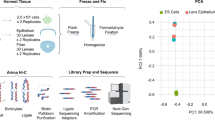Abstract
InDrosophila the Polycomb group (Pc-G) proteins are responsible for the stable and heritable silencing of genes. The Pc-G apparently uses heterochromatin-like mechanisms to transcriptionally inactivate developmental regulators such as the homeotic genes. The Polycomb (Pc) protein is part of a large multimeric complex composed of other members of the Pc-G. We have identified functionally relevant domains of the Pc protein by sequencing differentPc alleles. Additionally, using a Pc-βgal fusion protein with deleted internal histidine repeats, we found that this mutant protein cannot bind to four particular target loci, but otherwise does not change the remaining overall binding pattern. We show that, in contrast to the dotted subnuclear localization of the wild-type protein, the nuclear distribution of mutant proteins becomes homogeneous. Surprisingly, inPc mutants the polyhomeotic protein, another member of the Pc-G, is also redistributed in the nucleus. Our results indicate that the appropriate subnuclear localization of the two proteins is critical for the silencing function of the Pc-G complex.
Similar content being viewed by others
References
Ascoli C, Maul G (1991) Identification of a novel nuclear domain.J Cell Biol 112: 785–795.
Brunk BP, Martin EC, Adler PN (1991)Drosophila genesPosterior sex combs andSuppressor (2) of zeste encode proteins with homology to the murinebmi-1 oncogene.Nature 353: 351–353.
Bunker CA, Kingston RE (1994) Transcriptional repression byDrosophila and mammalian Polycomb group proteins in transfected mammalian cells.Mol Cell Biol 14: 1721–1732.
Clark RF, Elgin SCR (1992) Heterochromatin protein 1, a known suppressor of position-effect variegation, is highly conserved inDrosophila.Nucleic Acids Res 20 6067–6074.
DeCamillis M, Cheng NS, Pierre D, Brock H (1992) Thepolyhomeotic gene ofDrosophila encodes a chromatin protein that shares polytene chromosome-binding sites withPolycomb.Genes Dev 6: 223–232.
Eissenberg JC, James TC, Foster-Hartnett DMet al. (1990) Mutation in a heterochromatin-specific chromosomal protein is associated with suppression of position-effect variegation inDrosophila melanogaster.Proc Natl Acad Sci USA 87: 9923–9927.
Fauvarque MO, Dura JM (1993)polyhomeotic regulatory sequences induce developmental regulator-dependent variegation and targeted P-element insertions inDrosophila.Genes Dev 7: 1508–1520.
Franke A, DeCamillis M, Zink Det al. (1992)Polycomb andpolyhomeotic are constituents of a multimeric protein complex in chromatin ofDrosophila melanogaster.EMBO J 11: 2941–2950.
Fusconi M, Cassani F, Govoni Met al. (1991) Anti-nuclear antibodies of primary biliary cirrhosis recognize 78–92-kD and 96–100 kD proteins of nuclear bodies.Clin Exp Immunol 83: 291–297.
Grigliatti T (1991) Position-effect variegation — an assay for nonhistone chromosomal proteins and chromatin assembly and modifying factors.Methods Cell Biol 35: 587–627.
James TC, Elgin SCR (1986) Identification of a nonhistone chromosomal protein associated with heterochromatin inDrosophila melanogaster and its gene.Mol Cell Biol 6: 3862–3872.
Jürgens G (1985) A group of genes controlling the spatial expression of the bithorax complex inDrosophila.Nature 316: 153–155.
Laurenson P, Rine J (1992) Silencers, silencing and heritable transcriptional states.Microbiol Rev 56: 543–560.
Lewis EB (1978) A gene complex controlling segmentation.Nature 2761: 565–570.
Lonie A, D'Andrea R, Paro R, Saint R (1994) Molecular characterization of thePolycomlblikegene ofDrosophila melanogaster, atrans-acting negative regulator of homeotic gene expression.Development 120: 2629–2636.
Messmer S, Franke A, Paro R (1992) Analysis of the functional role of thePolycomb chromo domain inDrosophila melanogaster.Genes Dev 6: 1241–1254.
Palladino F, Laroche T, Gilsonet al. (1993) SIR3 and SIR4 proteins are required for the positioning and integrity of yeast telomeres.Cell 75: 543–555.
Paro R (1993) Mechanisms of heritable gene repression during development ofDrosophila.Curr Opin Cell Biol 5: 999–1005.
Paro R, Hogness D (1991) The Polycomb protein shares a homologous domain with a heterochromatin-associated protein ofDrosophila.Proc Natl Acad Sci USA 88: 263–267.
Paro R, Zink B (1992) ThePolycomb gene is differentially regulated during oogenesis and embryogenesis ofDrosophila melanogaster.Mech Dev 40: 37–46.
Pearce JJ, Singh PB, Gaunt S (1992) The mouse has a Polycomb-like chromobox gene.Development 114: 921–9292.
Powers JA, Eissenberg JC (1993) Overlapping domains of the heterochromatin-associated protein HP1 mediate nuclear localization and heterochromatin binding.J Cell Biol 120: 291–299.
Rastelli L, Chan CS, Pirrotta V (1993) Related chromosome binding sites forzeste, suppressors of zeste and Polycomb group proteins inDrosophila and their dependence onEnhancer of zeste function.EMBO J 12: 1513–1522.
Saunders WS, Cooke CA, Earnshaw WC (1991) Compartmentalization within the nucleus: discovery of a novel subnuclear region.J Cell Biol 115: 919–931.
Saunders WS, Chue C, Goebl Met al. (1993) Molecular cloning of a human homologue ofDrosophila heterochromatin protein HP1 using anti-centromere autoantibodies with antichromo specificity.J Cell Sci 104: 573–582.
Spofford JB (1969) Single-locus modification of position-effect variegation inDrosophila melanogaster. II. Region 3C loci.Genetics 62: 555–571.
Tartof KD, Bremer M (1990) Mechanisms for the construction and developmental control of heterochromatin formation and imprinted chromosome domains.Development (suppl): 35–45.
Tiong SYK, Russell MA (1990) Clonal analysis of segmental and compartmental homeotic transformations inPolycomb mutants ofDrosophila melanogaster.Dev Biol 141: 306–318.
van der Lugt NMT, Domen D, Linders Ket al. (1994) Posterior transformations, neurological abnormalities, and severe hematopoietic defects in mice with a targeted deletion of thebmi-1 proto-oncogene.Genes Dev 8: 757–769.
van Lohuizen M, Frasch M, Wientjens E, Berns A (1991) Sequence similarity between the mammalianbmi-1 protoncogene and theDrosophila regulatory genesPsc andSu(z)2.Nature 353: 353–355.
Wustmann G, Szidonya J, Taubert H, Reuter G (1989) The genetics of position-effect variegation modifying loci inDrosophila melanogaster.Mol Gen Genet 217: 520–527.
Zink B, Paro R (1989) In vivo binding pattern of a trans-regulator of homoeotic genes inDrosophila melanogaster.Nature 337: 468–471.
Author information
Authors and Affiliations
Corresponding author
Rights and permissions
About this article
Cite this article
Franke, A., Messmer, S. & Paro, R. Mapping functional domains of the Polycomb protein ofDrosophila melanogaster . Chromosome Res 3, 351–360 (1995). https://doi.org/10.1007/BF00710016
Received:
Accepted:
Issue Date:
DOI: https://doi.org/10.1007/BF00710016




